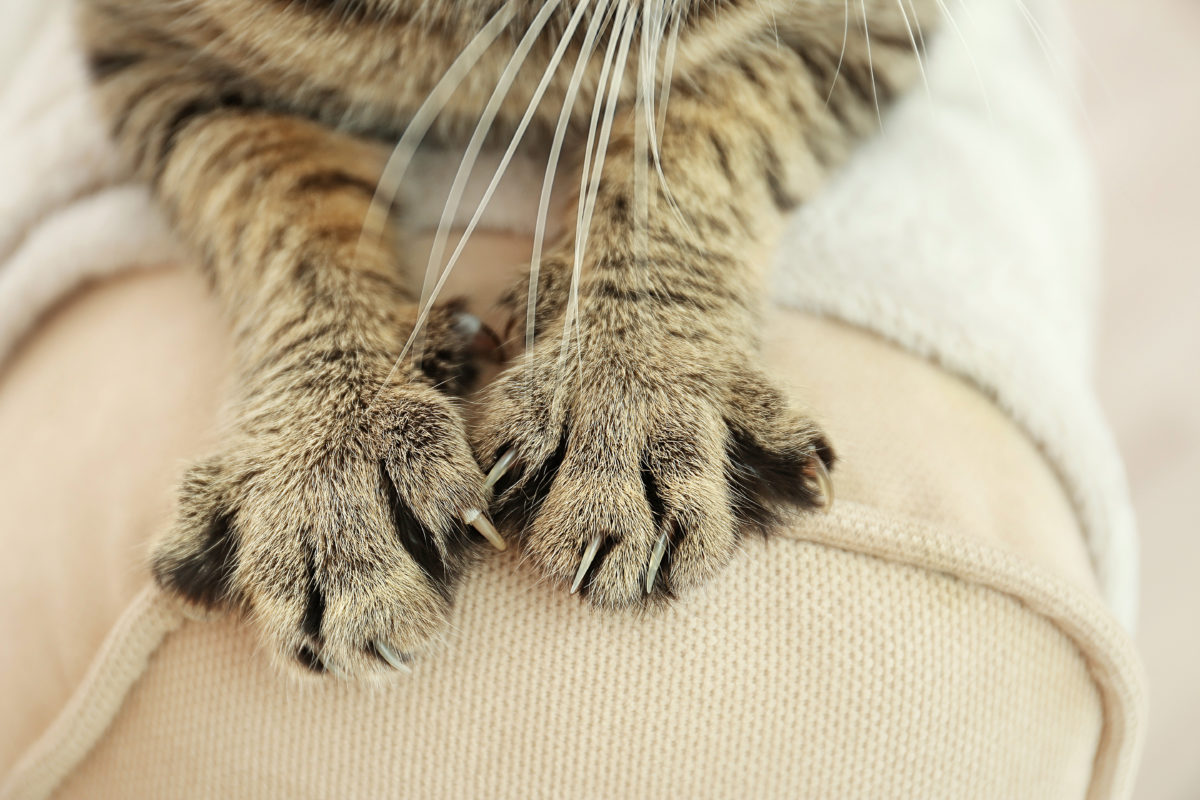Recent studies show that declawing can significantly increase the risk of long-term adverse effects on feline physical and emotional health, including chronic neuropathic pain, biting, and an increased likelihood of house-soiling. Here’s what you should know if you’re considering this procedure for your cat.
Declawing is an emotional, controversial, and divisive topic. Some people consider it an option to prevent destructive damage in the home and protection from potential scratches. Others consider the elective procedure inhumane, unethical mutilation that should be performed only to treat true medical conditions, such as nail bed cancer.
Pain and adverse behavior
The term “declaw” may sound straightforward, yet it misrepresents the extent of the surgical procedure.
“Declawing is also known as onychectomy or partial digital amputation,” says Margie Scherk, DVM, DABVP. “The surgery is actually amputation of the cat’s third toe or finger bone. Cats’ nails are different than those of humans in that they are actually part of the bone. A comparison in human terms would be cutting off a person’s finger at the last joint of each finger.”
Whether by scalpel, laser, or guillotine method, the procedure isn’t without risk or complications, nor is it pain free, Dr. Scherk says. Studies show declawed cats often experience pain from remaining bone fragments; nail regrowth; reluctance to move or play; lameness; and chronic pain. All of those factors result in the following negative effects:
- Reduced quality of life from chronic pain.
- Significantly higher odds of back pain due to change in gait kinetics.
- Greater likelihood of excessive grooming and fur chewing (barbering).
- Greater likelihood of aggression than non-declawed cats; that aggression is appreciably higher in declawed cats with bone remnants.
“Being in chronic pain understandably results in less positive interactions and lower acceptance of handling for some individuals,” Dr. Scherk says.
In one study, 63 percent of declawed cats had residual bone fragments, and those cats were 10 times more likely to eliminate outside the litter box.
“Whether that is because the litter hurts the hidden damaged nerves or for other reasons isn’t known,” says Dr. Scherk. “We do know, at the very least, that cats experience pain directly where the nerves were severed.”
Currently, 39 countries have enacted legislation prohibiting medically unnecessary declawing. In January 2019, Labrador and Newfoundland join two other Canadian provinces, British Columbia and Nova Scotia, in banning declawing. In the U.S., it is illegal in eight cities in California and in Denver, Colorado. No state has passed legislation banning declawing.
Scratch this!
Claws and scratching are an innate part of being a cat. The instinctual behavior cannot be unlearned or surgically removed by declawing–even declawed cats engage in the scratching motion.
All cats, even indoor cats, need their claws for balance, mobility, protection, grooming, and gripping prey and objects. Cats naturally scratch to promote nail health to shed the outer nail husk, stretching for isotonic exercise which leaves spine and joints supple, and to mark territory by leaving visual and scent marks (pheromones deposited from scent glands in the paws). Scratching may also act as a pressure valve, allowing cats to release pent-up stress.
For all of these reasons, it’s important to seek alternatives to declawing and to teach cats to direct their scratching toward appropriate surfaces.
“We can manage where and what a cat scratches, by placing a desirable, stable scratching surface in locations that a cat needs to mark,” Dr. Scherk says. “Scratching can be a result of not meeting kitty’s environmental needs. We have to learn to see the world from the cat’s point of view, regardless of how comfy we think we have made it for them.”
Use of synthetic pheromone products can reduce or redirect the need to mark. The chemical messengers encourage cheek marking, and one, Feliscratch, can attract cats to the scratching post.
Positive reinforcement in the form of treats, play, and praise can help as well. Be patient and give the cat time to learn what you want.
Regular nail trims help reduce damage to home decor and the risk of injuries from scratches. Remember that not every nail must be trimmed every time.
Plastic nail caps adhered to your cat’s claws are another option. They don’t hurt your cat, the adhesive is nontoxic, and the caps come in a variety of fun colors that are easy to see when they naturally fall off in 4 to 6 weeks. If you aren’t sure about how to trim your cat’s nails or apply nail caps, your veterinarian can show you how or do it for you. You may also search your area for mobile veterinarians who make house calls to assist you.
Nearly 25 percent of pet cats in the United States are declawed and most of the procedures occur before the cat is 8 months old. If your cat is declawed, take special care of those sensitive paws and be aware that some behaviors may be an expression of pain. If declawing is the only way you can have a cat, consider adopting one from your local shelter who is already declawed.
This article was reviewed/edited by board-certified veterinary behaviorist Dr. Kenneth Martin and /or veterinary technician specialist in behavior Debbie Martin, LVT.








